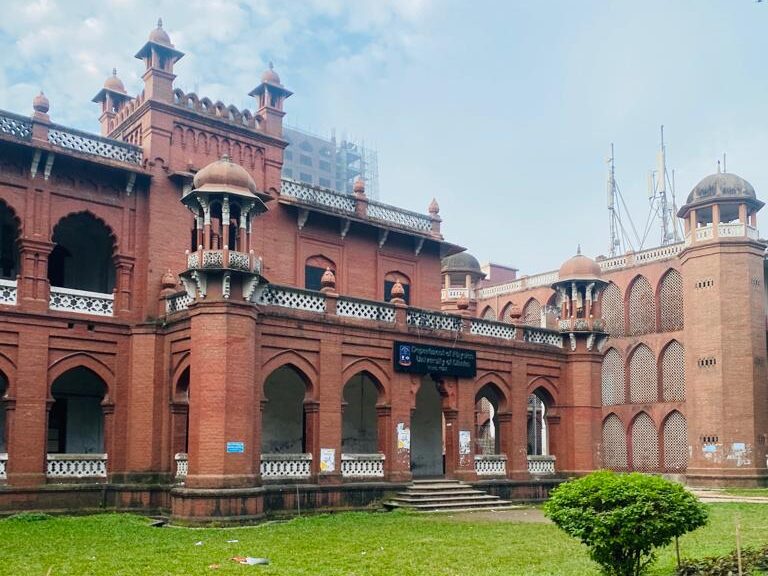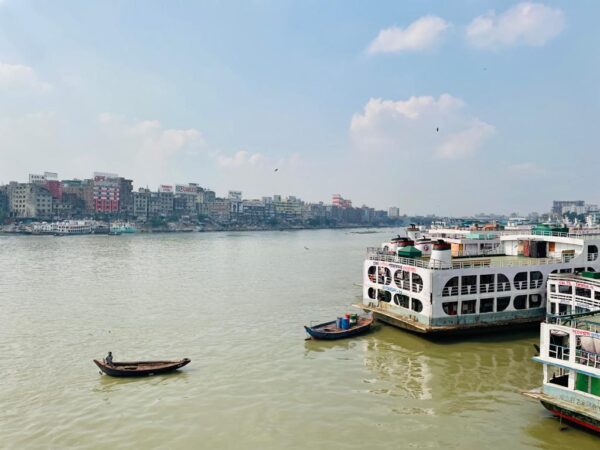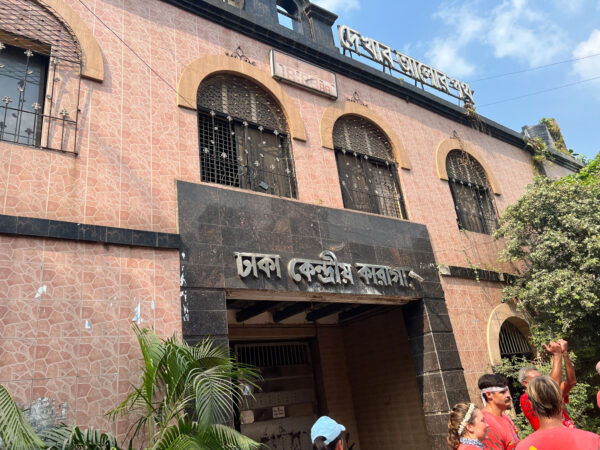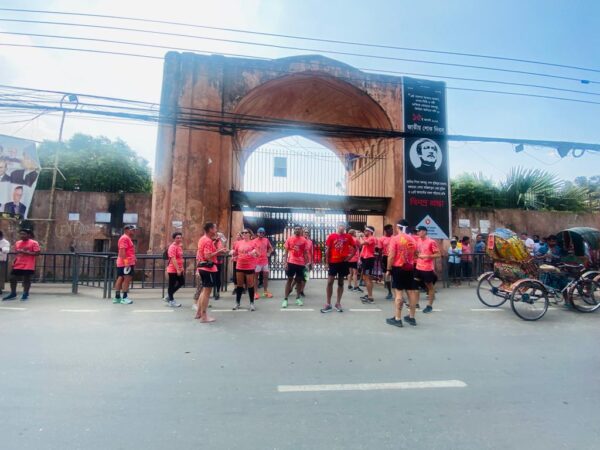In my previous post, I shared impressions of Old Dhaka gained from an unscripted walk and a 30-minute ride on one of the small ferries. Recently, however, I had the opportunity to enjoy a completely different kind of tour of Old Dhaka – somehow simultaneously more organized and more disorganized – with the Dhaka Hash House Harriers. It was a run that would turn out to be much more than I had planned for.

For those unfamiliar with “hashing,” this is an activity in which a group of runners follow a route unknown to all except one or more “hares” who laid out a trail earlier. The whole thing culminates in a ritual in which participants reminisce about the day’s route, while highlighting achievements and – more often – infractions committed by their fellow runners…typically all involving the consumption of beer. Originating with British military officers posted in colonial Malaysia in the early 20th century, the tradition now includes thousands of clubs and chapters worldwide, typically bringing together expatriates and locals in a spirit of camaraderie…and a little bit of what many would describe as “cultishness.” It’s a great way to discover previously unseen parts of the city in which one lives – and that includes folks who’ve lived in the host city their entire lives. In Dhaka, this is a 40-year-old tradition.
I had taken part in a handful of hashes since our arrival in Dhaka, but in truth was having a hard time adjusting. I arrived in relatively poor physical shape for running, but each of the events I had participated in had been a struggle of surviving the heat and humidity of Dhaka, not so much a sightseeing run. One of the hashers who had encouraged me to join previous events was sending me messages that this hash, in particular, was one not to miss. I didn’t want to go – I expected a late night at work that likely wouldn’t see me in bed before 3 am, and the lack of sleep was a useful excuse to avoid braving the heat. But he wouldn’t let up. In the end, I agreed to go, but on the day of the event, it took all my willpower to avoid turning off the alarm and rolling back to sleep.

The adventure started at Curzon Hall, part of Dhaka University’s school of science. Built in 1904, the hall was named after Lord Curzon, who was Viceroy of India at the time. Curzon is remembered for having proposed the brief partition – along religious lines – of Eastern Bengal and Assam from the rest of British India between 1905 and 1912. Language plays a major role in Bangadesh’s struggle for independence, which would be achieved in 1971; and it was at Curzon Hall where Dhaka University students in 1948 first voiced their refusal to accept Urdu as the state language in all of Pakistan, sparking the Language Movement.

We would continue on to the “Swadhinata Sangram,” a sculpture garden on the grounds of Dhaka University. Inaugurated in 1999, the sculpture garden was designed by the sculptor Shamim Sikder and represents the struggle and pride of the Bengali nation, featuring a main sculpture topped by Bangladesh’s national flag which is surrounded by 103 smaller statures, mostly representing the faces of pioneering leaders, poets, and renowned persons of Bengali culture and history. Of course, we stopped for the obligatory group shot.


We continued on to another large sculpture, the Shaheed Minar. This statue commemorates students killed on February 21 and 22, 1952, in demonstrations demanding official status for their native tongue, Bengali. It was built and rebuilt a number of times after being repeatedly demolished by the Pakistani government until Bangladesh gained its independence in 1971. Every February 21, Bangladesh recognizes the martyrs of its native language movement. In 2002, the UN General Assembly designated February 21 as International Mother Language Day as part of a broader initiative “to promote the preservation and protection of all languages used by peoples of the world.”

Next, we were off to visit the college dorm. In the early 1900s as Dhaka University was taking shape, the planning commission recommended a hall for the Muslim students to allow them to maintain their own culture and religion. The Muslim Hall was originally on the first floor of the Secretariat House, but as the university and the number of enrolled students grew, The Salimullah Muslim Hall as it currently exists was constructed and eventually inaugurated in August 1931. It currently houses more than 800 students.
After departing the Dhaka University area, we made our way through the narrow streets and markets of Old Dhaka. We passed by (but didn’t enter) Lalbagh Fort and posed in front of the slightly ajar front door of Dhaka’s Central Jail . Shopkeepers found the string of runners passing by, all dressed in identical pink t-shirts, quite curious, I’m sure.
We continued past the Tara Masjid, or “Star Mosque,” which was under renovation, and spent some time at the Armenian Apostolic Church of the Holy Resurrection, situated in the Armanitola area of Old Dhaka, once the nerve center of a bustling Armenian community in Dhaka. The church was built in 1781 on what had been an Armenian graveyard.



We’d finish our running tour of Old Dhaka at the Ahsan Manzil, a palace built by the Nawab Abdul Ghani from 1859 to 1872. It was later painted pink and turned into a museum, displaying a total of 4077 artifacts in 23 rooms open for exhibition. When we visited, the museum was still closed, but the organizers of the hash had arranged for us to enter the grounds for (you guessed it) more group photos.


And that should have been the end of the hash. Typically, these events run a few hours in the afternoon and you’re home in time for a shower and dinner. Today, however, we had started in the morning and I assumed we would wrap things up in the nearby parking lot. Instead, we filed onto one of the large riverboats parked along the Buriganga River that cuts through the capital and forms the southern edge of Old Dhaka. Once aboard, the boat pushed out into the center of the river and I realized we weren’t quite done.




For the next three hours, we headed south down the river, toward the Bay of Bengal. Food and drink were served, and the event turned into a floating dance party!

I’m starting to learn that Dhaka is full of surprises. Today was no exception!













